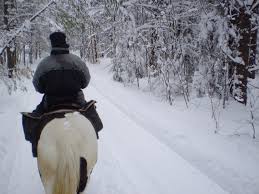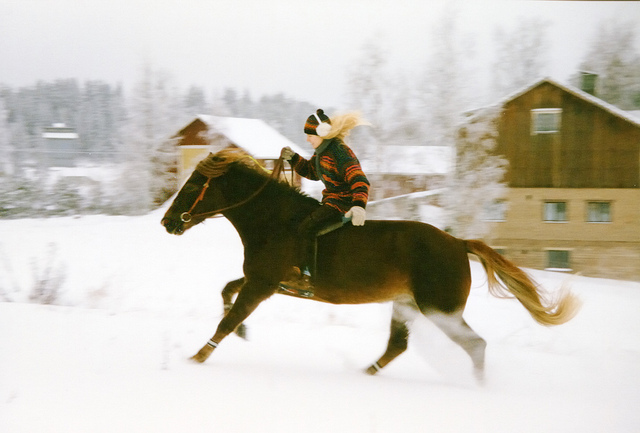HEAD FOR THE ...
|
|
WINTER HORSEBACK RIDING CAN BE FUN, BUT SPECIAL CARE IS NEEDED
From the Bangor Daily News, Bangor, ME
By Cassie Elia, Special to the BDN
Posted November 18, 2011
By Cassie Elia, Special to the BDN
Posted November 18, 2011

It is inevitable. There will be snow, cold and ice. For some horse owners, this means hanging up the saddle and giving the horse some time off. Others forge ahead. With careful preparation, riding in the winter can be enjoyable and safe.
Some riding stables have an indoor riding arena, which eliminates the concern of icy footing and biting wind. For those not so fortunate, riding can be done outside as long as there isn’t ice or deep, crusted-over snow. Horses are very capable in the snow, but when it gets that frozen layer over the top, it is difficult for the horses to break through and they may even lacerate their lower legs. It also impedes their movement which could result in a fall of both horse and rider.
For the winter months horses should either go barefoot, with no horseshoes, or have special snow-tire-like shoes with caulks and a pad between the hoof and shoe that keeps snow from balling up. Horses’ hoofs are cupped, so snow will pack in if horses wear typical metal shoes, which makes hooves like bowling balls and the horse very unsteady. Disaster is eminent.
Some riding stables have an indoor riding arena, which eliminates the concern of icy footing and biting wind. For those not so fortunate, riding can be done outside as long as there isn’t ice or deep, crusted-over snow. Horses are very capable in the snow, but when it gets that frozen layer over the top, it is difficult for the horses to break through and they may even lacerate their lower legs. It also impedes their movement which could result in a fall of both horse and rider.
For the winter months horses should either go barefoot, with no horseshoes, or have special snow-tire-like shoes with caulks and a pad between the hoof and shoe that keeps snow from balling up. Horses’ hoofs are cupped, so snow will pack in if horses wear typical metal shoes, which makes hooves like bowling balls and the horse very unsteady. Disaster is eminent.

With a barefoot horse, or one fitted with winter shoes, riding outside through snow-covered trails is a most enjoyable outdoor activity. Some considerations are important, however. In order to carry a rider through deep snow, a horse has to work extra hard, so be aware of horses’ fitness and exertion during an outside ride. If a horse has a full winter coat, it can quickly become very sweaty with the extra effort required to plow through snow, and care must be taken to keep that horse warm after a ride until its coat has dried. The drying process can take hours. It may be a better idea to limit physical work to avoid having a horse sweat a lot. They can’t shed layers if they get warm the way riders can.
For the rider, wearing appropriate gear can be a challenge. Riders can’t wear slippery snow pants or chunky boots to ride in. One will make it hard to stay on, and the other makes it hard to get your foot out of the stirrup should you not stay on. While a fall off a horse into the snow isn’t a bad way to land, it can be an awfully long walk home should that horse decide that he has urgent business to attend to back at the barn.
For the rider, wearing appropriate gear can be a challenge. Riders can’t wear slippery snow pants or chunky boots to ride in. One will make it hard to stay on, and the other makes it hard to get your foot out of the stirrup should you not stay on. While a fall off a horse into the snow isn’t a bad way to land, it can be an awfully long walk home should that horse decide that he has urgent business to attend to back at the barn.
|
Photo credit: The Horse Collaborative (flickr.com/smerikal)
|
One of the more comfortable ways to ride in winter is going bareback — the horse’s back, not the rider’s. A horse with a broad enough back can be lovely to sit on in winter. They are natural seat warmers. A narrower horse, while still warm, isn’t as cushiony to sit upon.
Riding should never be attempted on ice. Horses do not handle ice well. Occasionally, there will be a horse that can figure out how to safely negotiate an icy patch, but the majority of them play out the Bambi scene from the Disney movie. Except in this case, Bambi weighs a thousand pounds or more and it isn’t cute when he comes crashing down, limbs all akimbo. Horses can easily fracture a leg falling on ice, so not only should ice be avoided when riding but if your paddocks are icy, horses may need to stay in the barn until there is sufficient snow to cover them or it melts. Some horse owners will outfit their horses with studded horseshoes just to avoid an accident at pasture. In general, horses will avoid ice naturally, but sometimes, they get goofing around and don’t pay attention to the footing. |
Horses are quite adapted to cold weather and as long as they don’t get wet from rain, snow or sweat, they are very comfortable being outside. Wintertime in Maine has its challenges for keeping horses, but the opportunities for some spectacular riding should not be missed. If a horse — not a rider — is barefoot and bareback, riding amongst the snow covered pine trees is a dreamy way to get through the winter.
Looking for people who love to trail ride...
We love to ride and experience new places. Sometimes close to home for a nice relaxing day...sometimes for vacation to explore some place new. But where to go? This is not always easy to answer. Some people are fortunate to have a network of horse friends who can recommend a place; other people may not have that fortune. It is not always easy packing up your equine and heading for the hills, not knowing if there are facilities to accommodate you and your equine to your liking. You do not always know the skill level of riding that is necessary when you get their either. Throwing your bedroll on the back of your saddle and grabbing your saddle bags, should be fun and enjoyable!
Wild Heart Mustangs™ wants YOU, the reader, to write in with places you have been and can recommend to other people who love to trail ride! CONTACT US and send photos of places you love to share with your horse, mule or donkey.
Wild Heart Mustangs™ wants YOU, the reader, to write in with places you have been and can recommend to other people who love to trail ride! CONTACT US and send photos of places you love to share with your horse, mule or donkey.


